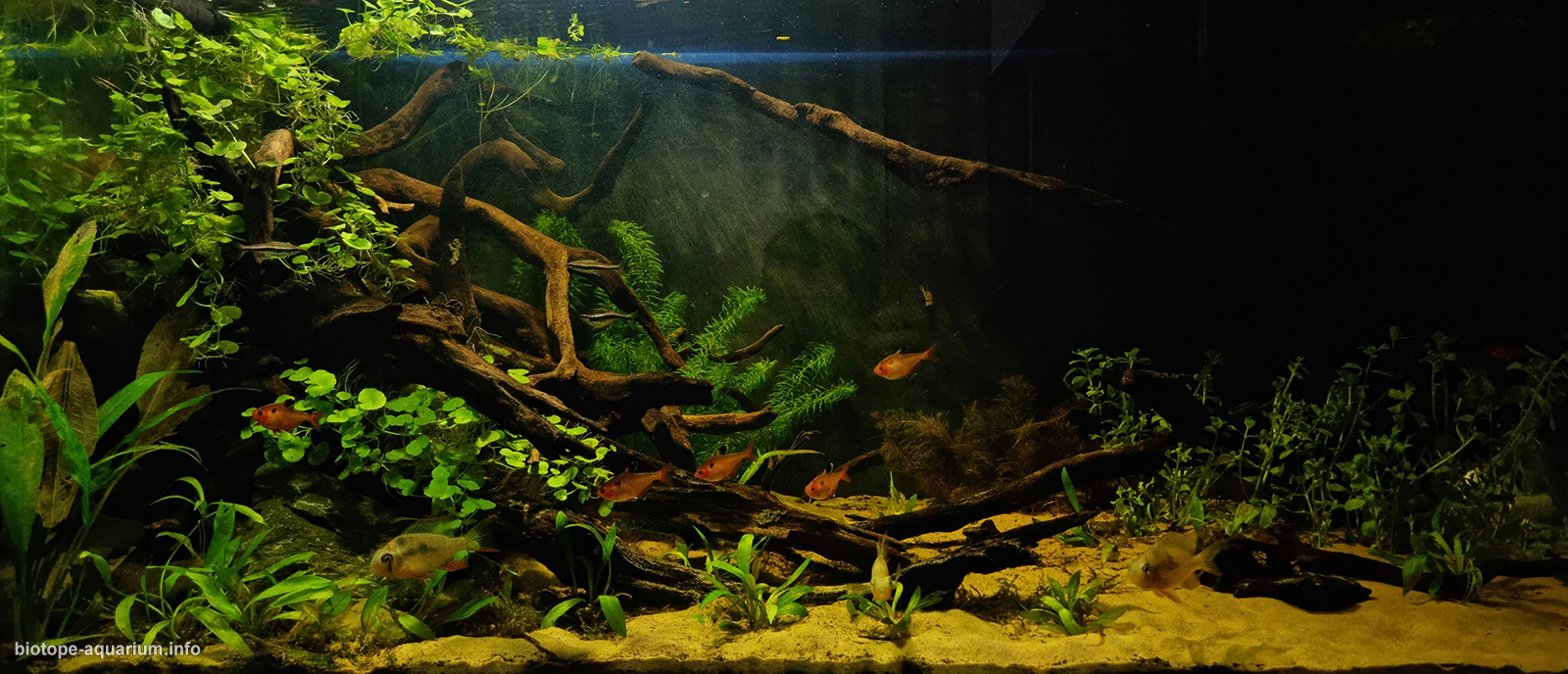Guaporé River drainage – Bolivia
_st place in Biotope Aquarium Design Contest 2022

Volume of aquarium: 250 liters
Dimensions of aquarium: 100x50x50
List of fishes: Mikrogeophagus Altiispinosus X6
Hiphessobrycon serape
Nannostomus spp.
List of plants: Egeria najas
Myriophillum matogrossense
Hydrocotile leucephalandra
Bacopa moonieri
Echinodorus bolivianus
Echinodorus tenellus
Echinodorus bleheri
Limnodium leavigatum
Description of Decorations and Substrate: Fine sand, driftwood and siliceous rocks
Description of Equipment: Filter Oase biomaster 600
Light Cetus2
Water Parameters: Ph 6.5
Kh 1
Temp.24°C
Additional Info: Water change once a week 10% RO
Aquarium video:
Description of the Area Surrounding the Biotope: This river flows for 1,540 km between northeastern Bolivia (where it is known by the Spanish name of Rio Iténez) and west-central Brazil. Born in the Serra dos Parecis mountain range in Mato Grosso, at about 650 m high: it receives the waters of the Rio Verde and forms the border between Bolivia and Brazil for a long stretch, before entering in turn with a mouth in the Rio Mamoré . It crosses regions characterized by a climate that is not strictly tropical: in the hottest months (winter-spring) there are in fact air temperatures often above 30 ° C, while in the colder ones (corresponding to our summer) the values frequently drop around 15 ° C, sometimes even dropping below 10 ° C
Description of the Underwater Landscape of the Biotope: Description of the underwater landscape of the biotope *
the Guaporé hosts a decidedly tropical flora and fauna, thanks also to its considerable flow which allows it to maintain a relatively stable temperature, rarely below 20 ° C. The river is characterized everywhere by particularly soft water (dKH and dGH both lower than 1 °!) And slightly acidic (pH around 6.5), classifiable as oligotrophic, i.e. relatively poor in dissolved nutrients: among others, almost not measurable with common aquarium tests are nitrates and phosphates. The bottom is for long stretches made up of white and rather fine quartz sand, mixed with mud and clay along the calmer and more marshy banks. The water is generally clear except during the rainy period, when especially in the upper section, the Guaporé overflows, forming numerous secondary streams and pools, very interesting biotopes rich in aquarium organisms.
Description of the Habitat Parameters: Ph 6.5
Kh 1
Gh1
Temp.20° – 30°
List of Fishes and Invertebrates Occurring in the Nature Biotope: Astronotus crassipinnis, Apistogramma trifasciata, A. maciliensis, A. luelingi, A. sp. “Guaporé”, A. staecki, Mesonauta festivus, Crenicichla johanna, Aequidens awani, Laetacara dorsigera, Microgeophagus altispinosus (Cichlidae); Corydoras haraldschultzi, C. hastatus, C. caudimaculatus, C. cochui, C. guapore, C. polystictus, C. sterbai (Callichthyidae); Tatia aulopygia (Auchenipteridae); Amblydoras hancocki (Doradidae); Pseudoplatystoma tigrinum (Pimelodidae); Megalamphodus megalopterus, Cheirodon kriegi, Gymnocorymbus ternetzi, Hyphessobrycon callistus, H. bentosi rosaceus, Thayeria obliqua (Characidae); Rivulus punctatus (Rivulidae); Potamotrygon motoro (Potamotrygonidae
List of Plants Found in the Nature Biotope:
Echinodorus grandiflorus, E. tenellus, E. paniculatus (nella foto in basso), E. bolivianus, E. grisebachii, Limnophila indica, Cabomba furcata, Ottelia brasiliensis, Eichhornia azurea, E. crassipes, E. diversifolia, Egeria najas, Najas conferta, Ludwigia sedoides, Limnobium laevigatus, Salvinia auriculata, Hydrocleys nymphoides, Utricularia breviscapa, U. hydrocarpa
Threats to the Ecology of the Biotope: Human activity has had and continues to have a major impact on Bolivia’s natural ecosystems. In historical times, the isolated forests of the Andes, composed mainly of an evergreen species of the genus Polylepis (locally known as queñua), were almost totally destroyed for civil uses (wood and construction).
In tropical areas, the natural environments were preserved almost intact until the mid-twentieth century. The effects on ecosystems of the high population density during the development of the hydraulic culture of las Lomas are only conceivable given that the macroclimatic changes of the thirteenth century decimated those populations, forcing them to semi-nomadism. During the boom in the exploitation of rubber, in the forests of northern Bolivia, in the current departments of Beni and Pando, between the end of the nineteenth century and the beginning of the twentieth century, there were local negative effects on the fauna which, however, re-established itself once. the economic boom of mining has ceased.
Sources of Information:
https://www.natureaquarium.it/pub.htm
https://www.fishbase.de/
https://it.m.wikipedia.org/wiki/Pagina_principale
